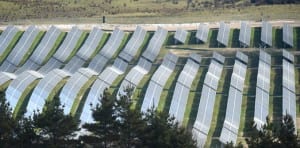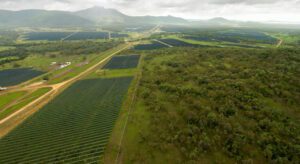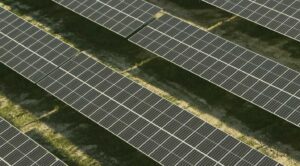Solar developer Ingenero has completed Australia’s first dual-axis tracker solar array for an electric vehicle charging station, on South Australia’s Kangaroo Island. The installation is located at the island’s airport and has been coupled with three electric cars and six electric charging stations.
Teaming solar installations with EV charging stations is a trend that has been emerging in recent years internationally, with Tesla rolling out an growing fleet of EV charging stations in the U.S. The first such development has taken place in Australia, with a four-tracker installation at Kangaroo Island’s airport being coupled with three Nissan Leafs and electric charging stations around the island.
The former Renewables SA initiated and funded the project, with dual-axis tracking technology chosen to be a highly visible demonstration of solar technology. When planning the project, solar developers Ingenero decided to increase the landmark nature of the project by coupling it with the small EV fleet and charging stations.
The $500,000 project employs four trackers, that follow the sun over the day, increasing the output of the Trina modules installed. The four trackers have a capacity of 50kW and a 14kW roof mounted array was installed to Kangaroo Island’s council chambers as a part of the project.
One of the Nissan Leafs will be used by the council as a fleet vehicle with the other two being made available for rental from the local Budget car rental branch. They will remain owned by the council.
Six “level two” electric vehicle charging stations have been installed in the major townships around Kangaroo Island. Each will charge a car in around four hours from empty. The ability to get good coverage around the island with the chargers, but with longer charge times, was behind the decision to go with more of “level two” chargers, rather than just two fast-charge stations.
“The car fleet has around 80% coverage of the entire island, which given the size of Kangaroo island is no mean feat,” said Ingenero’s National Sales Manager, Patrick Greene.
The solar, e-mobility and e-charging system is grid based, meaning that it is “virtual” solar charging. The installations feed electricity back into the grid and the charting stations draw from the grid. “At two of the sites where the chargers are, the council and the airport,” said Greene, “there is more than enough solar power being generated at to meet the load and to contribute to the car charging, so it’s a nominal thing.”
E-mobility is an attractive proposition on Kangaroo Island, given that petrol shipped to the island demands an approximate 15% premium compared to the mainland.
The tracker technology itself will result in the solar arrays producing 30 – 40% electricity more electricity than a stationary installation. Spanish company Mecasolar provided the tracking technology and hardware. Mecasolar has supplied a range of projects internationally, including a 5 MW project in Spain, the Fustinana Solar Park in Navarra, Spain, during the country’s brief but bright solar boom that peaked in 2008. 500 13kW trackers were used in the Fustinana installation.
“One of the benefits of the tracking technology is that it produces quite a smooth output curve throughout the day,” said Ingenero’s Patrick Greene. “So the arrays come online and operate more-or-less at peak capacity very early in the morning and they are relatively consistent in terms of output until 5pm or 6pm.”
The smoother production curve right across the day better meets demand loads and also assists in supporting the relatively fragile Kangaroo Island grid. While the island is connected to the mainland power grid, through two undersea cables, capacity remains constrained and some of the island’s electricity is produced using diesel generators.
Despite the advantages of double-axis tracking on Kangaroo Island, Ingenero’s Greene says that the technology is not suited all around Australia. “Generally speaking dual-axis tracking doesn’t make as much economic sense in Queensland and in northern New South Wales, where the dual-axis tracker might increase production by 20% as opposed to 40%, so you have to weigh that up against the additional capital costs of the system,” said Greene.
The Kangaroo Island installation was the last major project to be developed by the former Renewables SA body.









